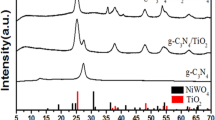Abstract
Porous peanut-like TiO2/BiVO4 composite nanostructures were synthesized via a template-free hydrothermal process with bismuth nitrate, ammonium metavanadate and anatase TiO2 as raw materials. The crystal structures, morphologies, and optical properties of the as-prepared samples were characterized by X-ray powder diffraction, transmission electron microscope, scanning electron microscopy, X-ray photoelectron spectroscopy and UV–visible absorption spectra. Simulated sun-light induced photocatalytic degradation of Rhodamine B by porous peanut-like TiO2/BiVO4 nanostructures in the absence and presence of H2O2 has been investigated, and the results show these porous composite nanostructures with higher photocatalytic activity than pure BiVO4 and anatase TiO2. When TiO2/BiVO4 heterostructures were used as the photocatalysts under simulated sun-light irradiation, BiVO4 could act as a sensitizer to absorb the visible light. Meanwhile, coupling different band-gap semiconductors of TiO2 and BiVO4, the compound facilitate separation of the photogenerated carriers under the internal field induced by the different electronic band structures of semiconductors.









Similar content being viewed by others
References
W. Doerffler and K. Hauffe (1964). J. Catal. 3, 156–170.
M. R. Hoffmann, S. T. Martin, W. Y. Choi, and D. W. Bahnemann (1995). Chem. Rev. 95, 69–96.
S. S. Thind, G. S. Wu, and A. C. Chen (2012). Appl. Catal. B 111–112, 38–45.
T. L. Thompson and J. T. Yates Jr (2006). Chem. Rev. 106, 4428–4453.
E. M. Rodríguez, G. Fernández, P. M. Álvarez, R. Hernández, and F. J. Beltrán (2011). Appl. Catal. B 102, 572–583.
H. Liu, M. Y. Wang, Y. Wang, Y. G. Liang, W. R. Cao, and Y. Su (2011). J. Photochem. Photobiol. A 223, 157–164.
J. Thomas and M. Yoon (2012). Appl. Catal. B 111–112, 502–508.
Y. C. Zhang, Z. N. Du, K. W. Li, M. Zhang, and D. D. Dionysiou (2011). ACS Appl. Mater. Interfaces 3, 1528–1537.
Z. Bian, J. Zhu, S. Wang, Y. Cao, X. Qian, and H. Li (2008). J. Phys. Chem. C 112, 6258–6262.
C. H. Han, Z. Y. Li, and J. Y. Shen (2009). J. Hazard. Mater. 168, 215–219.
J. Xu, W. Z. Wang, S. Sun, and L. Wang (2012). Appl. Catal. B 111–112, 126–132.
Y. Liu, F. Xin, F. Wang, S. Luo, and X. Yin (2010). J. Alloys Compd. 498, 179–184.
E. V. Skorb, E. A. Ustinovich, A. I. Kulak, and D. V. Sviridov (2008). J. Photochem. Photobiol. A 193, 97–102.
L. Huang, F. Peng, H. J. Wang, H. Yu, and Z. Li (2009). Catal. Commun. 10, 1839–1843.
Z. D. Meng, L. Zhu, J. G. Choi, C. Y. Park, and W. C. Oh (2011). Nanoscale Res. Lett. 6, 459–469.
A. P. Zhang, J. Z. Zhang, N. Y. Cui, X. Y. Tie, Y. W. An, and L. J. Li (2009). J. Mol. Catal. A 304, 28–32.
W. I. F. David and I. G. Wood (1983). J. Phys. C 16, 5149–5166.
K. Hirota, G. Komatsu, M. Yamashita, H. Takemura, and O. Yamaguchi (1992). Mater. Res. Bull. 27, 823–830.
K. Shantha and K. B. R. Varma (1999). Mater. Sci. Eng. B 60, 66–75.
A. Galembeck and O. L. Alves (2000). Thin Solid Films 365, 90–93.
T. Yang and D. Xia (2009). J. Cryst. Growth 311, 4505–4509.
H. M. Zhang, J. B. Liu, H. Wang, W. X. Zhang, and H. Yan (2008). J. Nanopart. Res. 10, 767–774.
X. Zhang, Y. Zhang, X. Quan, and S. Chen (2009). J. Hazard. Mater. 167, 911–914.
M. Shang, W. Wang, L. Zhou, S. Sun, and W. Yin (2009). J. Hazard. Mater. 172, 338–344.
X. Zhang, Z. An, F. Jia, L. Zhang, X. Fan, and Z. Zou (2007). Mater. Chem. Phys. 103, 162–167.
G. C. Xi and J. H. Ye (2010). Chem. Commun. 46, 1893–1895.
L. Zhang, D. R. Chen, and X. L. Jiao (2006). J. Phys. Chem. B 110, 2668–2673.
Y. F. Sun, Y. Xie, C. Z. Wu, S. D. Zhang, and S. S. Jiang (2010). Nano Res. 3, 620–631.
L. Ren, L. L. Ma, L. Jin, J. B. Wang, M. Q. Qiu, and Y. Yu (2009). Nanotechnology 20, 9–405602.
G. S. Li, D. Q. Zhang, and J. C. Yu (2008). Chem. Mater. 20, 3983–3992.
G. Q. Zhu, and W. X. Que. (2012) J. Cluster Sci. doi:10.1007/s10876-012-0531-6.
Z. J. Li, W. Z. Shen, W. S. He, and X. T. Zu (2008). J. Hazard. Mater. 155, 590–594.
J. Yu, Y. Zhang, and A. Kudo (2009). J. Solid State Chem. 182, 223–228.
H. B. Li, G. C. Liu, S. G. Chen, Q. C. Liu, and W. M. Lu (2011). Phys. E 43, 1323–1328.
A. Martínez-de la Cruz and U. M. G. Pérez (2010). Mater. Res. Bull. 45, 135–141.
Z. J. Zhang, W. Z. Wang, M. Shang, and W. Z. Yin (2010). Catal. Commun. 11, 982–986.
F. J. Benitez, J. R. Francisco, L. A. Juan, and C. Garcia (2006). J. Hazard. Mater. 138, 278–287.
Y. P. Zhao, J. Y. Hu, and W. Jin (2010). Environ. Sci. Technol. 42, 99–104.
S. Kaniou, K. Pitarakis, I. Barlagianni, and I. Poulios (2005). Chemosphere 60, 372–380.
M. Hojamberdiev, G. Q. Zhu, A. Eminov, and K. Okada (2012). J. Cluster. Sci. doi:10.1007/s10876-012-0522-7.
L. Q. Guo, F. Chen, X. Q. Fan, W. D. Cai, and J. L. Zhang (2010). Appl. Catal. B 96, 162–168.
Author information
Authors and Affiliations
Corresponding author
Rights and permissions
About this article
Cite this article
Cao, B., Peng, J. & Xu, Y. Simulated Sunlight-Driven Degradation of Rhodamine B by Porous Peanut-Like TiO2/BiVO4 Composite. J Clust Sci 24, 771–785 (2013). https://doi.org/10.1007/s10876-013-0571-6
Received:
Published:
Issue Date:
DOI: https://doi.org/10.1007/s10876-013-0571-6




